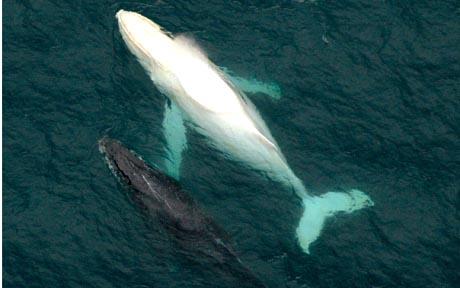
Migaloo, a 45.9 feet (14-meter), 34.4 ton (35-ton) pure white humpback whale, is seen here swimming along the east coast off Australia, near Coffs Harbour with another whale, Tuesday, June 15, 2005. (Sea Experience Charters, Greer Atkinson).
June 30, 2009

Migaloo, a 45.9 feet (14-meter), 34.4 ton (35-ton) pure white humpback whale, is seen here swimming along the east coast off Australia, near Coffs Harbour with another whale, Tuesday, June 15, 2005. (Sea Experience Charters, Greer Atkinson).
Migaloo is a rare white male humpback whale first spotted in 1991. Experts believe he is now about 21 to 23 years old.
Slipping silently past his biggest fans along the Gold Coast of August — during the dead of night – the big white whale did it again.
On Wednesday morning, July 1, 2009, local time, the rare white whale is expected to be powering past Moreton Island after being spotted off the NSW north coast yesterday, June 30th.
Until now, the albino humpback has been able to keep away from the paparazzi as he migrates north.
“With any luck he’ll be out of media range by the morning,” said Blue Planet Marine’s Dave Paton, who spotted Migaloo about 3km off Evans Head on June 30. “He’s got a good habit of ducking and weaving the media.”
On Tuesday, June 30, 2009, Australian authorities had warned the public to stay away from a rare white humpback whale named Migaloo that has made an appearance off the east coast of that country.
Officials in Queensland state have declared Migaloo a “special-interest whale” and banned anyone from coming within 500 metres of him.
Anyone coming too close by boat, jet ski or aircraft will face a fine of $13,500AU.
Officials said the whale needed to be left alone to migrate up the coast.
“The whale-watching regulations are there to protect the whales, but also to protect people from these huge, unpredictable animals,” said Queensland’s Environment Minister Kate Jones.
“Adult humpbacks can weigh more than a fully-loaded semi-trailer so you need to stay out of their way,” she added.
Migaloo is the only known all-white humpback whale in the world, Professor Peter Harrison of the Southern Cross University Whale Research Centre told the BBC News website.
“He’s a very special whale,” Harrison said. “Nothing should divert him on his migration route to the Great Barrier Reef.”
Migaloo, which means “white fella” in a Queensland aboriginal dialect, is from Australia’s Great Barrier Reef area, but migrates every southern summer to the waters off Antarctica to feed on krill.
He has attracted a loyal following since he was first spotted as a young whale in 1991. Speculation about the whale’s gender was resolved in October 2004 when researchers from Southern Cross University collected sloughed skin samples from Migaloo as he migrated past Lennox Head, and subsequent genetic analysis of the samples proved he is a male.
There are websites dedicated to him and he inspired an anti-whale hunt campaign, Operation Migaloo, last year.
Aside from curiosity seekers, the other big threat to Migaloo and other humpbacks is the potential resumption of hunting by Japanese whalers in the Southern Ocean, Harrison said.

About Loren Coleman
Loren Coleman is one of the world’s leading cryptozoologists, some say “the” leading living cryptozoologist. Certainly, he is acknowledged as the current living American researcher and writer who has most popularized cryptozoology in the late 20th and early 21st centuries.
Starting his fieldwork and investigations in 1960, after traveling and trekking extensively in pursuit of cryptozoological mysteries, Coleman began writing to share his experiences in 1969. An honorary member of Ivan T. Sanderson’s Society for the Investigation of the Unexplained in the 1970s, Coleman has been bestowed with similar honorary memberships of the North Idaho College Cryptozoology Club in 1983, and in subsequent years, that of the British Columbia Scientific Cryptozoology Club, CryptoSafari International, and other international organizations. He was also a Life Member and Benefactor of the International Society of Cryptozoology (now-defunct).
Loren Coleman’s daily blog, as a member of the Cryptomundo Team, served as an ongoing avenue of communication for the ever-growing body of cryptozoo news from 2005 through 2013. He returned as an infrequent contributor beginning Halloween week of 2015.
Coleman is the founder in 2003, and current director of the International Cryptozoology Museum in Portland, Maine.
Filed under Breaking News, Cryptotourism, CryptoZoo News, Megafauna, Photos, Weird Animal News